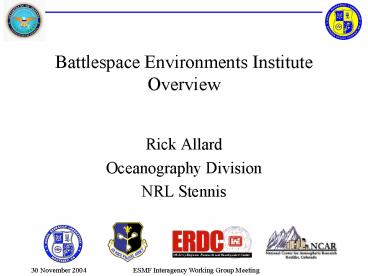Battlespace Environments Institute Overview PowerPoint PPT Presentation
1 / 16
Title: Battlespace Environments Institute Overview
1
Battlespace Environments InstituteOverview
- Rick Allard
- Oceanography Division
- NRL Stennis
2
BEI Overview
- Facilitate the integration of Earth and space
modeling capabilities into a seamless,
whole-earth common modeling infrastructure
allowing the inter-service development of
multiple, mission-specific environmental
simulations. (GOAL) - Support battlefield decisions, improve
interoperability, reduce operating costs,
streamline the transition of cutting-edge
environmental technologies from research into DoD
operations. (GOAL) - Use the Earth System Modeling Framework (ESMF) as
an enabling technology to develop the
whole-earth system. Bring in DoD as a partner to
the ESMF. Transition non-DoD ESMF applications
to DoD. (STRATEGY) - Foster wider collaborations between DoD, multiple
government agencies, academia and industry.
3
BEI Stakeholders
Convergence to a common modeling infrastructure
will improve interoperability, reduce operating
costs, and most importantly streamline the
transition of cutting-edge technologies from
research into DoD operations. (COL Bensen, AFWA)
The development of a framework to support
internally consistent modeling of the entire
(land-sea-air) battlespace environment is
important to our strategic goal of providing
essential guidance with respect to environmental
factors that impact warfighter decisions. (CAPT
Gunderson, FNMOC)
- Dr. James Houston, ERDC
- Dr. Ed Gough, CNMOC TD
- Dr. Michele Rienecker, NASA GMAO
- Dr. Tim Killeen, Director, NCAR
- Dr. Stephen Lord, Director, NCEP
- Modeling Center
- Dr. John Harding, Acting, NAVO
- Dr. Ants Leetma, Director, GFDL
- COL Bensen, AFWA
- Dr. Phil Jones, Los Alamos
- CAPT Gunderson, FNMOC
4
BEI Stakeholders
- DoD Stakeholders Navy (CNMOC, NAVO, FNMOC), Air
Force (AFWA), Army (ERDC) - Air Force-AFWA convergence to a common modeling
infrastructure will improve interoperability,
reduce operating costs, and streamline transition
of cutting-edge technologies from research to DoD
operations. - Army-ERDC The BEI, designed to support
battlefield decisions will promote the
development of common modeling infrastructure and
advancement of Earth system prediction
capabilities. - Navy-CNMOC goalto progress to a full coupling
of environmental models to predict warfighters
total battlespace environment-from beneath the
sea floor to space, and from blue water to
terrain. - Wider Community NSF NCAR, NOAA GFDL and NCEP,
DOE LANL and ANL, NASA JPL and GMAO, universities.
5
Institute Management Framework
6
Institute Technical Framework
- Technical Teams
- Army (ERDC) Groundwater, riverine
- Air Force (AFWA) Space weather, WRF
- Navy (NRL-SSC) Ocean dynamics (waves, currents,
ice), coupling - Navy (NRL-MRY) Atmospheric modeling, enhancements
and coupling - NCAR ESMF Core Team, unstructured grids, WRF,
new capabilities for DoD - Management
- NRL-SSC Provides Technical, Financial Oversight
7
(No Transcript)
8
Present (non-ESMF) Capabilities
9
Example of NRL East Asian Seas NCOM
ESMF-based applications will help DoD streamline
model transition, maintenance and upgrades.
GLIDER vs EAS
ARGOS vs EAS
10
Battlespace Environments Institute Objectives
- To develop a DoD-wide whole-earth environment
which interoperates with that from other
agencies - Migrate core DoD models to ESMF
- Navy (e.g., NCOM, HYCOM, SWAN, COAMPS)
- Air Force (Kinematic Solar Wind and GAIM )
- Army (e.g., ADCIRC, WASH123)
- Development of tools and applications (e.g.,
extend ESMF to support unstructured grids and
nesting) - Coupled applications Air/ocean, air/ocean/ice,
air/ocean/groundwater, air/space-weather - Thorough testing, prototyping, documentation of
all components
11
Battlespace Environments Institute NRL MRY
Short-Term Goals
12
NRL MRY Long-Term Goals
13
BEI NRL MRY Long-Term Goals
Explicit microphysics will allow the prediction
of large convective systems and tropical cyclone
structure and intensity
Two-way air/ocean coupling will enable the
analysis and prediction of high-resolution,
consistent fields in both the atmosphere and ocean
14
AFWA Space Weather Goals
- Couple ESMF versions of HAF and GAIM models
to provide DoD with the ability to extend the
forecast lead time of the arrival of a shock in
the solar wind created by a Coronal Mass Ejection
at the sun from 1 hour to 1-3 days.
Extreme space weather conditions (e.g.,
geo-magnetic storming) can adversely affect
communications, satellite orbit decay, satellite
charging and result in false radar targets.
15
Unstructured Grid Support (NCAR Lead)
- Ability to interpolate atmospheric model data in
native format to unstructured grids. - Build coupled applications where data can be
exchanged between models every nth timestep.
ADCIRC Mesh 2 400 m resolution
16
Guidelines for application development
- ESMF does not mandate how components interact.
- Need to define and implement the rules
(standards) a component must follow to be part of
the DoD whole-earth system. - Goal is NOT to require that all components from
space to underground run at the same time as one
system. - Instead, each organization uses the same
whole-earth system (software and standards) to
run the components of interest to them. - Once we have ESMF-compliant components we will
prototype the whole-earth system across limited
domains (e.g. littoral or air-ocean) - The prototypes will be immediately useful, but
the goal is to gain the experience necessary to
design and build a comprehensive whole-earth
system.
17
Long Term Goals and Metrics
- Goal DoDs in-house environmental RD is
primarily based in the whole-earth environment.
(FY05-10) - of HPC hours in environment
- of funding for projects in environment
- Goal DoDs operational environmental products
based in a whole-earth environment. (FY07-10) - Environments transitioned to operational
centers - of operational hours in environment
- of operational products
- Goal DoD whole-earth environment
interoperates with that from other agencies.
(FY08-10) - Multi-agency test cases
- of DoD multi-agency projects in environment
18
BEI Interaction with ESMF and Related Efforts
19
BEI Calendar
- Complete DRAFT Strategic Plan, Annual Performance
Plan (Dec 04) - ESMF Training (via PET) at Stennis January 18-19,
2005 - BEI Kickoff Meeting (Stennis) January 20-21, 2005
- HSAI Site Visit February 2005
- UGC June 2005 (Nashville)
- ESMF Community Meeting Summer 2005

